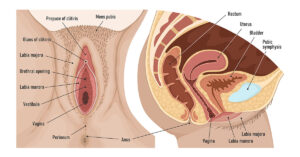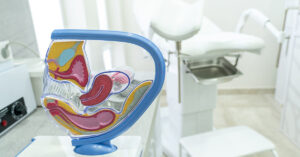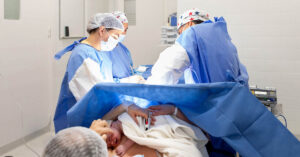The human body is incredibly diverse, and the female genital anatomy is no exception. If you are wondering why your vagina looks different from what you see in the media or hear about from other women, you might not be alone! Many ladies share concerns about their bodies, and one common question is about having a “fat” vagina.
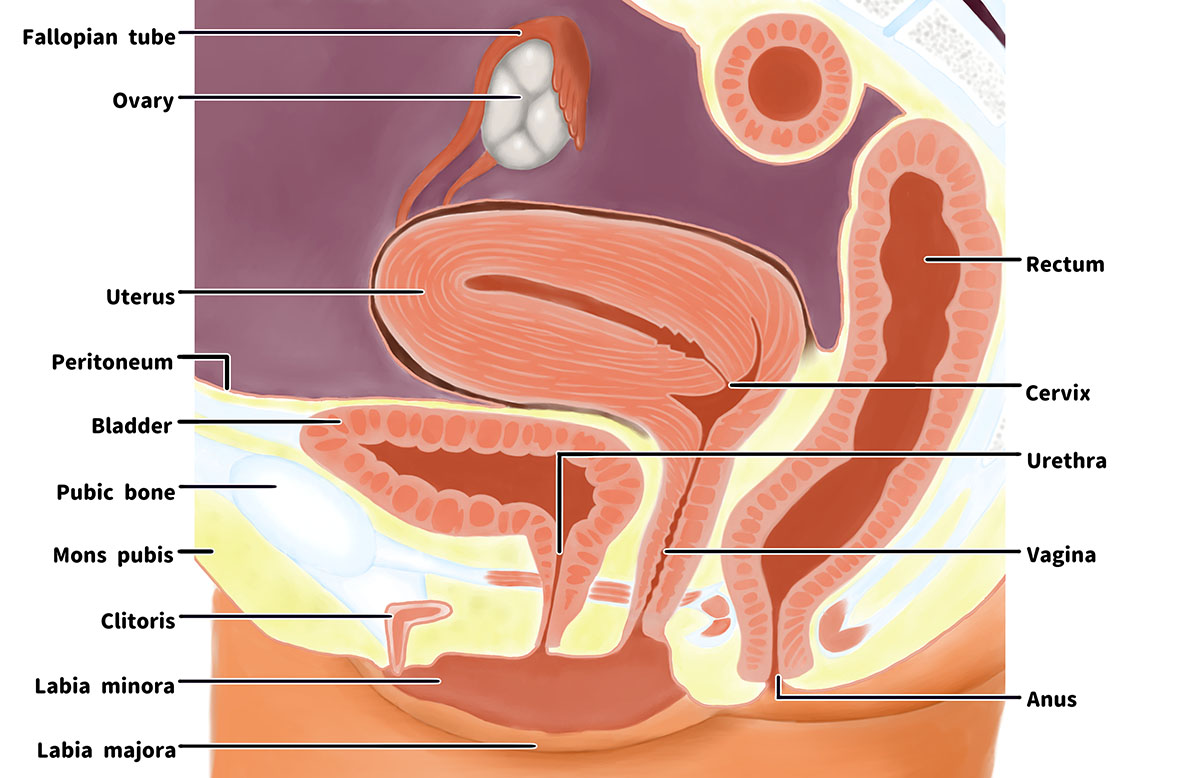
The truth is vaginas come in all shapes and sizes, and there is no “one normal.” This article discusses the natural variations in vaginal appearance and different types of vaginas while explaining why some might seem “fat” and highlighting the importance of embracing our unique bodies.
What Should A Vagina Look Like?
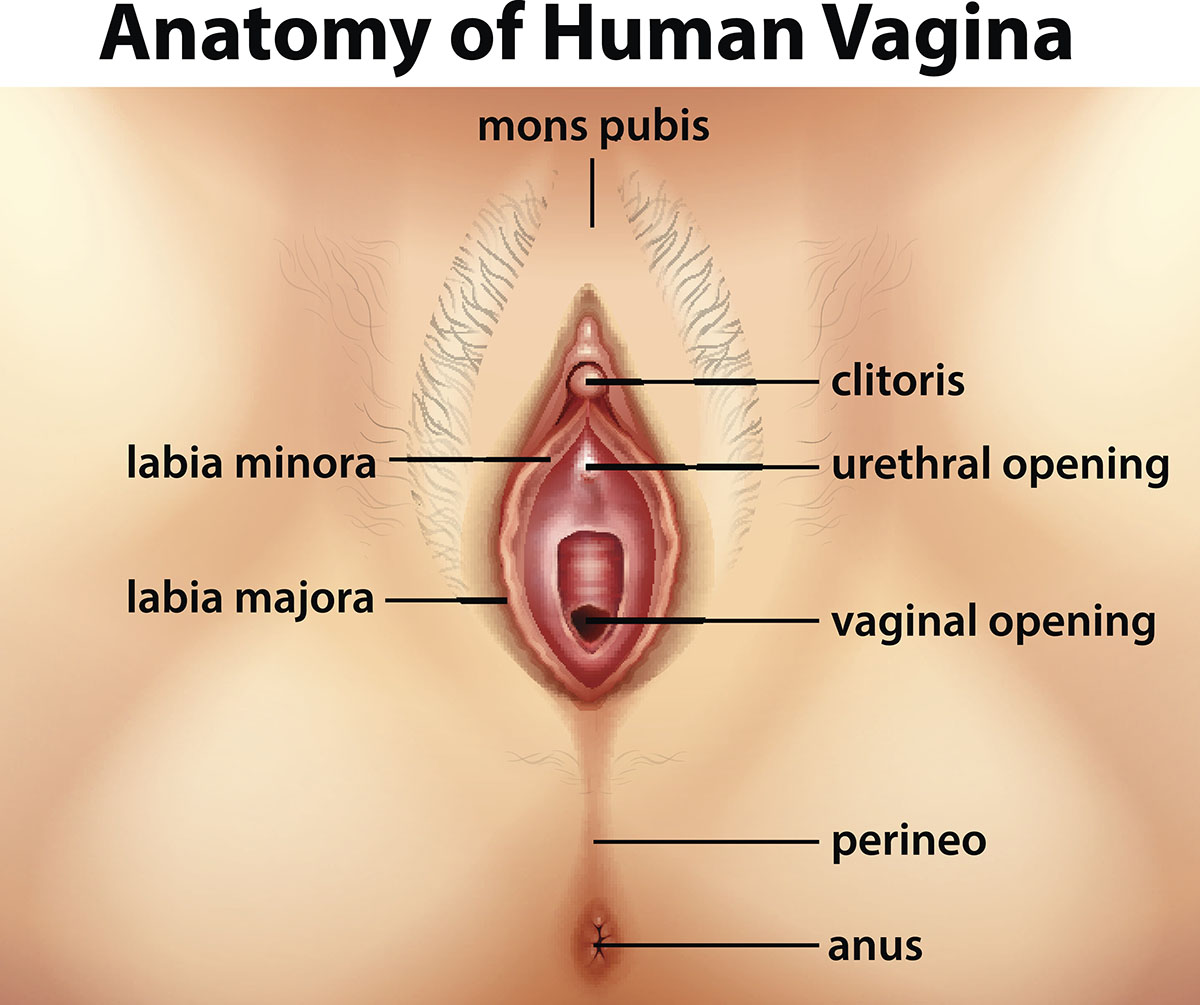
Before diving into what a vagina should look like, one must understand its anatomy correctly. It is important to clarify that when people refer to the “vagina” as being fat, they are often talking about the external genitalia, which is the vulva. The vulva has various parts consisting of different tissues with distinct functions and different issues. These include:
- The Labia:
This is made up of the labia majora and minora. The labia majora, often called the outer lips, are the fleshy folds where pubic hair grows. As the outermost part of the vulva, they contain fatty tissues and vary significantly in size and appearance. The labia minora, or inner lips, differ from the labia majora. They are typically softer, thinner, and hairless and contain fewer fatty tissues.
It is important to understand that labia sizes, shapes and colours come in a wide range. Sometimes the labia majora completely cover the labia minora, while other times, the labia minora protrude beyond the labia majora, both of which are entirely normal. The labia minora are rarely symmetrical and aren’t really supposed to be. They do not need to match perfectly, especially since these areas are hard for us to see. - The Mons Pubis
The mons pubis is a key component of the vulva, located above the labia. This rounded, fatty area of tissue covers the pubic bone and is often referred to as the “mons” or “pubic mound.” During puberty, the mons pubis becomes more pronounced due to hormonal changes, and it is typically covered with pubic hair. The primary function of the mons pubis is to provide a cushioning effect that protects the pubic bone during sexual activity and other physical activities. This padding helps to absorb impact and reduce discomfort.
Like other parts of the vulva, the appearance of the mons pubis can vary significantly from person to person. Factors such as body type, age, hormonal levels, and genetics all influence its size and shape. Some women may have a more prominent mons pubis, while others may have a flatter appearance. Both are completely normal and natural variations. Every mons pubis is unique, and its appearance can change over time due to factors like weight fluctuations, pregnancy, and aging. - Clitoris
The clitoris is the primary source of sexual sensation for women. Externally, it appears as a small, oval-shaped nub at the top of the labia minora, known as the “glans clitoris”. However, this visible part is just the tip of the iceberg. The clitoris extends internally in a wishbone shape around the vaginal canal.
The clitoris, the equivalent of the penis, may seem tiny but is quite significant. It sits above the urethral opening and is covered by a hood of tissue. Like the penis, it enlarges with arousal. The clitoris has about 10,000 nerve endings, making it extremely sensitive. - Clitoral Hood
The clitoral hood is a flexible fold of skin covering the glans clitoris. It varies in size, with some people having a larger, fleshier hood and others a smaller one. The clitoral hood protects the sensitive clitoris from friction and irritation. During arousal, it retracts to expose the glans clitoris, much like the foreskin on a penis. - Urethral Opening
The urethral opening is the small hole that connects the urethra to the vulva. Women urinate from the urethra, which leads from the bladder to the external opening. It is located just above the vaginal opening and below the clitoris; the urethral opening is separate from the vaginal opening. - Vaginal Opening
The vaginal opening is the external part of the vagina, located between the labia minora and below the urethral opening. It is where menstrual blood exits from, a channel for penetrative sex and from where babies are delivered during childbirth. The area around it, including the urethra, is called the vaginal vestibule. - The Vagina
The vagina, located internally, is a muscular canal that connects the vulva to the cervix. The vaginal walls produce discharge, which can vary in consistency throughout your cycle due to hormonal changes.
By understanding the diverse and complex nature of female anatomy, we can better perceive the shape, size and type of our bodies.
Why Is My Vulva Fat?

The perception of a “fat” vulva typically refers to the appearance of the labia majora or the mons pubis. These areas can sometimes appear fuller or more prominent due to various factors, which include:
- Genetic Influence On Fat Distribution
Just like other physical traits, the size and shape of your labia majora and mons pubis are largely determined by your genetic makeup. The distribution of adipose (fat) tissue in your body, including your vulva, is influenced by inherited genetic factors. These genes dictate how much fatty tissue is present in the labia majora and mons pubis, as well as the overall structure and shape of these areas.
Also, you might inherit the tendency for a fuller labia majora or mons pubis from your parents. These inherited traits are natural variations that contribute to the unique appearance of your vulva. Further, different ethnic groups and families may have variations in the typical distribution and amount of fatty tissue. - Impact of Hormones on Vulva Appearance
Hormones play a significant role in the distribution of fat in your body, and fluctuations in hormone levels can cause noticeable changes in the appearance of your vulva.- Puberty: During puberty, increased levels of estrogen lead to the development of secondary sexual characteristics, including the growth of the labia majora and the mons pubis, making them more prominent. These changes are a normal part of sexual maturation.
- Pregnancy: Hormonal changes during pregnancy, particularly increased levels of estrogen and progesterone, can cause an increase in blood flow and fluid retention in the vulva. This can make the labia majora and mons pubis appear fuller.
- Post-Menopausal Changes: After menopause, decreased hormone levels can lead to thinning of the vaginal tissues and a reduction in the amount of fat in the vulva. This can result in a different texture and a less prominent appearance.
- Influence of Body Weight
Your overall body weight can affect the amount of fatty tissue in the labia majora and mons pubis.- Weight Gain: When you gain weight, your body stores extra fat in various areas, including the vulva. This can make the labia majora and mons pubis appear more prominent. This is a normal response to weight gain and varies from person to person.
- Weight Loss: Conversely, losing weight can reduce the amount of fatty tissue in these areas, making them appear less prominent. The degree to which weight loss affects the vulva varies depending on how your body distributes fat.
- Age-Related Changes
As you age, your body undergoes various changes, including a redistribution of fat and changes in skin elasticity. These changes can affect the appearance of your vulva in several ways.- Loss of Skin Elasticity: Over time, the skin loses its elasticity due to a decrease in collagen and elastin production. This can cause the skin of the labia majora and mons pubis to become less firm and more prone to sagging.
- Changes in Fat Distribution: Aging can lead to a redistribution of fat in the body. For some women, this might mean a reduction in the fatty tissue of the labia majora and mons pubis, while others might experience an increase.
- Effects of Fluid Retention on Vulva Appearance
Temporary swelling due to fluid retention can make your vulva appear larger. Fluid retention can occur for various reasons, including hormonal fluctuations, dietary factors, and certain health conditions.
How Can I Reduce The Size Of My Vulva?
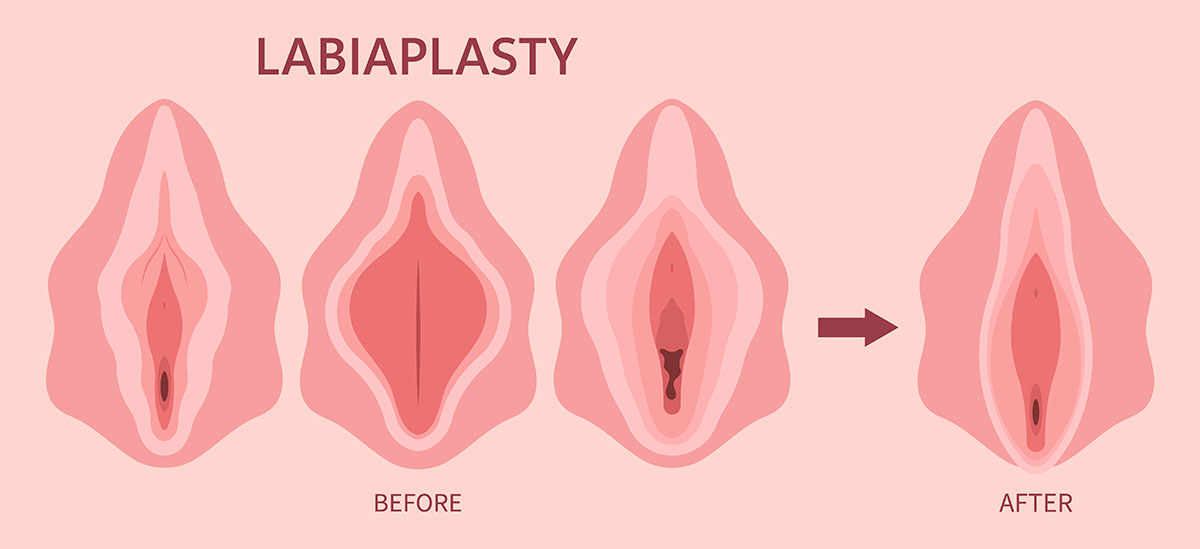
Reducing the size of the vulva is a personal choice, and women may seek it for various reasons, including physical discomfort or aesthetic preferences. The following surgical and non-surgical approaches can be used to achieve this.
Surgical Approaches
- Liposuction for Reducing Mons Pubis and Labia Majora Size
Liposuction is a surgical procedure that involves removing excess fat from specific body areas, including the mons pubis and labia majora. This cosmetic procedure is often sought by individuals looking to achieve a slimmer appearance in these areas when other methods, such as diet and exercise, have not been effective. A comprehensive consultation with a qualified plastic surgeon is essential to determine if liposuction is right for you. - Labiaplasty
Labiaplasty is a surgical procedure aimed at reducing the size of the labia minora and, in some cases, the labia majora. It is the most common surgical option for those seeking to alter the appearance of their vulva. Consulting with a board-certified plastic surgeon or gynecologist who specializes in labiaplasty is crucial. - Monsplasty
Monsplasty is a surgical procedure that reduces the size of the mons pubis by removing excess fatty tissue. It is less commonly performed but can be an option for those concerned about this area. It is often done in conjunction with an abdominoplasty.
Non-Surgical Approaches
- Weight Management
Maintaining a healthy diet and regular exercise is fundamental for overall health and can also determine the size of the vulva. For individuals whose vulva size is affected by body weight, adopting a comprehensive approach to weight management can lead to significant changes. - Balanced Nutritious Diet
Ensure your diet includes a balanced mix of carbohydrates, proteins, vegetables, fruits, and healthy fats. - Portion Control
Smaller, more frequent meals can help maintain energy levels and prevent overeating. Use smaller plates, eat slowly and aim for three main meals and two healthy snacks throughout the day. - Hydration
Staying well-hydrated is essential for metabolism and overall health. Aim to drink at least eight 8-ounce glasses of water daily, more if you are active or sweating a lot. - Regular Exercise
Cardiovascular exercises such as running, cycling, swimming, and brisk walking help burn calories, reduce body fat, and improve cardiovascular health. Aim for at least 150 minutes of moderate-intensity or 75 minutes of high-intensity cardio exercise per week. Other helpful exercises are targeted exercises such as bicycle crunches, mountain climbers, V-pulls, leg raises, pelvic tilts and forearm planks. These specific exercises can help tone the lower pelvic area, potentially reducing the appearance of the mons pubis. - Hormonal Management for Vulva Size
Hormonal fluctuations can significantly impact the size and appearance of the vulva, particularly the labia majora and mons pubis. Excess androgens, often resulting from conditions such as polycystic ovarian syndrome (PCOS), congenital adrenal hyperplasia, or ovarian virilizing tumours, can lead to an enlarged clitoris. Certain medications, like anabolic steroids, can also cause this enlargement.
If you suspect that hormonal imbalances are affecting the size of your vulva, it is advisable to consult with a healthcare professional, such as an endocrinologist or gynecologist. These specialists can assess your hormone levels and recommend appropriate treatments to address any underlying issues.
The Importance of Consulting A Professional

The appearance of the vulva varies greatly due to factors like genetics, hormonal changes, body weight, age, and fluid retention. Embracing this diversity is key to self-acceptance.
For those seeking to alter their vulva’s size, options range from non-surgical approaches like healthy lifestyle changes and hormonal management to surgical procedures like liposuction, labiaplasty, and monsplasty.
Consulting with a healthcare professional is essential to find the most appropriate approach. Labiaplasty NYC provides top-tier, minimally invasive gynecological procedures. Reach out today to schedule a consultation with our expert specialists.
References
- Nguyen JD, Duong H. Anatomy, Abdomen and Pelvis: Female External Genitalia. [Updated 2023 Jul 25]. In: StatPearls [Internet]. Treasure Island (FL): StatPearls Publishing; 2024 Jan-. Available from: https://www.ncbi.nlm.nih.gov/books/NBK547703/
- Farage M, Maibach H. Lifetime changes in the vulva and vagina. Archives of gynecology and obstetrics. 2006 Jan;273:195-202.
- Bykowski MR, Rubin JP, Gusenoff JA. The impact of abdominal contouring with monsplasty on sexual function and urogenital distress in women following massive weight loss. Aesthetic Surgery Journal. 2017 Jan 1;37(1):63-70.
- Skerrett PJ, Willett WC. Essentials of healthy eating: a guide. Journal of midwifery & women’s health. 2010 Nov 1;55(6):492-501.
- Alter GJ. Management of the mons pubis and labia majora in the massive weight loss patient. Aesthetic Surgery Journal. 2009 Sep 1;29(5):432-42.
